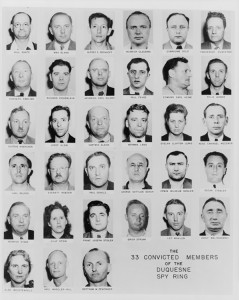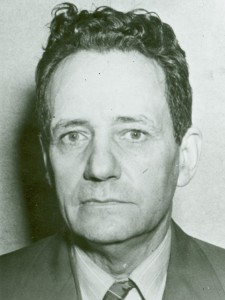The Duquesne Spy Ring
Tuesday, January 2nd, 2018January 2, 2018
On Jan. 2, 1942, 76 years ago today, a United States federal court sentenced 33 members of a Nazi German spy ring led by Frederick “Fritz” Duquesne to a total of over 300 years in prison. Duquesne and the 32 others had pleaded guilty or been convicted of espionage in the months leading up to the December 1941 Japanese attack on Pearl Harbor that brought the United States into World War II (1939-1945). The U.S. Federal Bureau of Investigation (FBI) brought down the spy ring with the critical help of a German-American citizen named William Sebold. The fall of the Duquesne Spy Ring resulted in the largest number of convictions of any single espionage case in U.S. history.

This composite shows the 33 convicted members of the Duquesne Spy Ring. Frederick Duquesne is at the top right. Credit: Library of Congress
William Sebold was a naturalized U.S. citizen who had worked in aircraft and industrial plants in the United States and elsewhere since leaving his native Germany in 1921. During a return trip to Germany in 1939, the German Secret Service asked Sebold to spy for the Nazis on the United States. Alarmed, Sebold reported the spy recruitment efforts to U.S. officials in Germany. The FBI directed Sebold to go through with the Nazi spy training. Sebold would then work as a double agent, pretending to spy for Nazi Germany while actually working for the FBI—an extremely dangerous occupation.
In 1940, after his Nazi spy training, Sebold returned to the United States. He began working among a network of Nazi spies in New York City. Sebold met with Nazi agents at a Manhattan office fitted with a two-way mirror and audio and video recording devices. FBI agents witnessed Sebold’s meetings with Nazi spies. They also altered communications from Sebold and relayed the misleading information to Germany.
Sebold’s Nazi contacts included Fritz Duquesne, a South African who had fought against the British during the second Boer War (1899-1902). Duquesne had lived off and on in the United States since 1902, and he was involved in numerous nefarious activities. In 1917, during World War I (1914-1918), he was arrested for insurance fraud and was found to be spying for Germany. Duquesne escaped U.S. captivity in 1919. He was arrested again in 1932, but was released. In the mid-1930′s, Duquesne became involved with pro-Nazi groups in the United States, and eventually resumed spying for Germany.
In 1940, Duquesne began meeting with Sebold. Duquesne relayed schedules of ships bound for England, advised Sebold on sabotage techniques, and passed along information on new U.S. military weapons and equipment. The FBI arrested Duquesne and his co-conspirators in June 1941. All 33 either pleaded guilty to spying for Nazi Germany or were convicted of espionage in court. Duquesne was sentenced to 18 years in prison. He was released in 1954 because of failing health, and he died in 1956 at age 78.
In 1942, overseas espionage and intelligence operations were taken up by the newly created Office of Strategic Services (OSS). The OSS was the forerunner of the Central Intelligence Agency (CIA), which was established in 1947.



